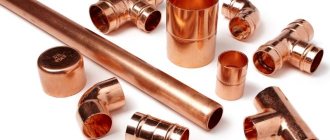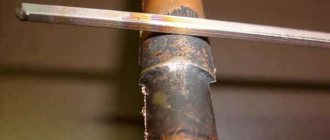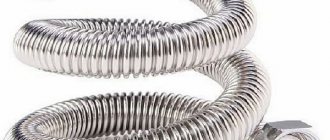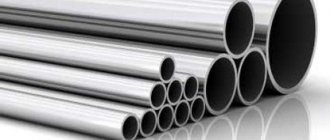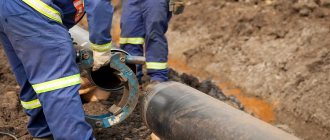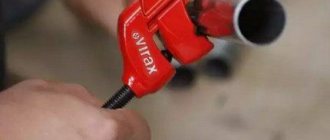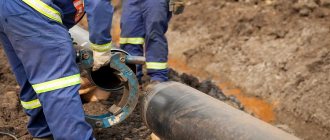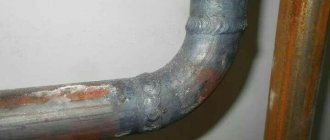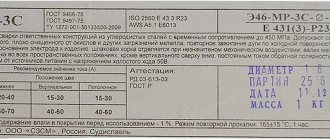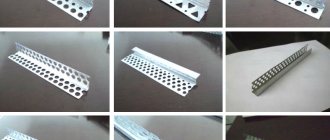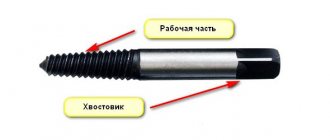Drilling pipes are included in drilling rigs. They act as a connecting link between the cutting tool (bit) and the drilling equipment. These parts are needed for lowering into the well, generating the required rotation and load, as well as lifting working tools from the bottom of the well to the surface. In addition, they supply drilling fluid, which performs the function of cooling the cutting element. Wells that are drilled using drilling equipment are classified according to production products (oil, gas, water, etc.).
A special type of pipe with high strength characteristics is used for drilling wells
Features of drill pipes
Pipes for drilling rigs do not have connecting seams - fastening of parts is ensured by special threaded locks. Drill pipes, which are part of the column structure, are connected with special nipples. All types of parts used in drilling rigs are manufactured in accordance with certain standards and regulations. The pipes themselves can have a square or round cross-section.
Depending on the material of manufacture, the following types of drill pipes are distinguished:
- Steel pipes . Steel products are the most common. The diameter of the steel drill pipe can vary from 34 to 168 mm. The standard diameter most often used in drilling equipment is 60 mm. Using these pipes, core drilling is carried out, which implies a high speed of rotation of the bit, so the rock is destroyed along a circular path. Steel pipes have an increased degree of reliability, which is why they are used for diamond mining.
- Light alloy pipes . Products made from such alloys may have different characteristics and features (one of the options for a light alloy pipe is a design with thickened ends and a round profile section). The wall thickness of light alloy pipes varies from 9 to 17 mm.
Drilling equipment is produced by pressing. Raw materials processed by this method must first undergo heat treatment, which will improve the characteristics of the source material. To connect parts, locks are used, which have a fairly lightweight design.
To improve the strength characteristics, the end parts of the parts are thickened, resulting in an increase in the weight of the drill pipe. A special coupling and locking nipple are attached to the extreme sections of the pipe by welding.
Production lines for the manufacture of drilling equipment take into account all the requirements for these parts, so the output, regardless of the strength group of the drill pipes, is high-quality elements that can perform their functions throughout the entire operational period.
The most important quality that drilling equipment must have is high corrosion resistance. The fact is that most parts are constantly exposed to moisture, so it is necessary to minimize the risk of material destruction. Increased corrosion resistance is achieved through special treatments. The same applies to threaded connections and other connecting elements - they all must be coated with anti-corrosion lubricant.
Self-propelled drilling and crane machines
Self-propelled drilling and crane machines are widely used in urban construction for the construction of pile foundations of buildings and structures, bridge supports, pipelines, power supply and communication lines, wells, fences, as well as for the construction of roads, planting trees and shrubs. They are joint drilling and special crane equipment mounted on the chassis of serial cars and tractors, driven by the engine of the base machine or an independent power plant. Drilling equipment is used to drill vertical and inclined wells in thawed and seasonally freezing soils using mechanical rotary drilling, and special crane equipment is used to install piles, pillars, reinforced concrete supports, well lining blocks and other elements into the drilled wells.
Based on the type of base machine, drilling and crane machines are divided into automobile and tractor; according to the principle of operation of drilling equipment - on cyclic and continuous machines; Based on the type of drive of drilling and crane equipment, machines with mechanical, hydraulic and mixed (hydromechanical) drives are distinguished; by type of design of drilling and crane equipment - into machines with combined (drilling and crane equipment are mounted on one mast) and separate (drilling equipment is mounted on a mast, crane equipment is mounted on a boom) equipment; if it is possible to rotate the working equipment in plan, the machines are divided into fixed and rotary; according to the location of the working equipment on the base chassis - with rear and side placement for non-rotating machines, on a rotating platform - for rotating ones.
The main parameter of drilling and crane machines is the maximum depth of the well being drilled (m). The main parameters include: drilling diameter (well), drilling angle (angle of inclination of the well axis to the horizon), lifting capacity of crane equipment.
Blade, annular and auger drills are used as replaceable drilling tools for crane drilling machines, fixed at the end of the drill rod, to which torque and feed force are imparted.
The blade drill (Fig. 1, a) consists of a body 1 with two digging blades in the form of a double-threaded screw, a drill bit 5 and a damper 2. The blades are equipped with replaceable cutters 4, which loosen the soil and are installed in tool holders 3. The drill bit, located at the end of the drill head, sets the direction of the drill and keeps it on the drilling axis. The flaps prevent soil from spilling out when excavating soil from a well. The drill is attached to the lower end of the drill rod using a pin. An auger (screw) drill (Fig. 1, b) is a tubular frame 9 with screw spirals transporting soil in the form of a solid tape 10. The auger has a shank 11 for fastening at the end of the drill rod. A replaceable drilling head 8 with cutters 7 and a drill bit 6 is attached to the auger.
Rice. 1. Drills for drilling and crane machines
The annular drill (Fig. 1, c) destroys the soil along the periphery and forms an annular gap separating the core from the massif. The drill consists of a body 12 in the form of a pipe, on the lower end of which cams 14 with cutters 15 are evenly located. The surface of the drill body is equipped with helical blades 13, transporting destroyed soil (rock) from the annular slot to the day surface. Two deflection bars 16 throw the destroyed soil to the outer wall of the annular slot.
When drilling wells in frozen soils, cutters and drill bits reinforced with carbide plates are used. Wells are drilled by rotating the drilling tool with its simultaneous downward movement. During the drilling process, a well of the required depth is formed in several repeating cycles, each of which includes sequentially performed drilling operations, lifting the drilling tool to the surface, unloading it and returning it to the bottom.
For drilling wells of various diameters, each drilling and crane machine is equipped with a set of replaceable drilling tools.
Types of drill pipes
All drill pipes are divided into two main types:
- Solid . This category of products is a monolithic part with thickenings at the edges. The production of such elements is carried out according to the scheme described above: first, the parts are calcined, and then undergo mechanical processing.
- Prefabricated . From a manufacturing perspective, the main difference in prefabricated drill pipe is the use of hot-rolled billets. Such elements are equipped with special elements that are screwed to the edges of the pipe.
Another way to classify drill pipes involves dividing them depending on the material of manufacture. The base raw materials can be steel or light alloys.
In addition, there is a classification according to which the following types of parts are distinguished:
- Regular;
- Weighted;
- Presenters.
Transportation, storage
To transport drill pipes, you can use all main types of transport - road, water, air, rail. For convenience, it is recommended to pack individual pipes in small bags that are convenient to carry and transport. In the case of railway or road transport, it is recommended to tie the packages to special bars that are securely fixed on the platform or in the truck. Tubular products may be transported by helicopter using cargo platforms.
Storage rules:
- The optimal storage method is to use shelving. Shelving must be securely fixed to prevent spontaneous rolling. The racks must be in contact with tubular products at least at three points (otherwise the safety of the products is not guaranteed). The minimum distance between the floor and the shelving support should be 35 centimeters.
- Parts should be sorted into groups. If damage is detected, the product must be placed on a separate rack. Each rack must be equipped with a small information plate that briefly describes the characteristics of the products (in the case of damaged products, a plate with the inscription “DAMAGE” must be attached).
- The most sensitive element is the thread. During storage in a warehouse, the threads of each product must be lubricated with a lubricant that prevents corrosion. The type of lubricant depends on many parameters - temperature conditions, storage duration and others. After applying a protective lubricant, the threads must also be protected using thread protectors, which increase the shelf life of the lubricant. The process of applying lubricant and protective coating is called preservation.
- If the seal is broken or the lubricant has expired, it is necessary to re-preserve it. To do this, the fuses are screwed together, and the remaining lubricant is wiped off using special rags. After this, a new layer of preservation lubricant is applied, and new protective parts are screwed on. The main examples of depressurization are contact with alkalis or acids, prolonged exposure to open air (more than 1 year), prolonged contact with water (more than 2 weeks).
Conventional drill pipes
For the manufacture of conventional pipes, steel or aluminum-based alloys can be used. The main distinguishing feature of this type of pipe is its round cross-section. The wall thickness of these products ranges from 4.75 to 11 mm. The connection of pipes is possible through the use of locks with conical threads.
Light-alloy drill pipes, which also belong to this type, in most cases undergo processing to increase the strength of the finished products. The edges of the parts are thickened, which significantly extends the service life of the pipes and increases their functionality.
Classification of installations by drilling method
Several drilling methods are used to mechanically destroy rock.
Drilling machines
Auger. The technical parameters of the work involve cutting rock destruction by a drilling mechanism with its simultaneous release to the surface.
Roller ball. Rock destruction occurs by impact, in which the rock is abraded and carried to the surface by an air flow.
The rotary impact drilling method is carried out using machines with an installed pneumatic hammer. Rock ejection occurs due to the operation of additional equipment - a compressor.
Types of drilling rigs used for specific rocks
Rotary drilling rigs. A rotating mechanism is installed at the face of the machine, which cuts out the rock. A weighted crown or chisel is used as a striker.
Rotary-impact installations. Rock cutting is carried out by simultaneous rotation of the face and impact strokes. The chisel or impact blank has a reinforcing amplifier. In some cases, a diamond crown is installed.
Impact (projectile) method. To make holes in loose, sedimentary rocks, a method is used based on impacts on an established face. The percussion drilling method is used to produce holes no larger than 100 m.
Impact drilling diagram
Vibration type structures. Vibration from the generator, which is the secondary machine of the drilling module, is supplied through the double pipe lines. The vibration probe cuts out the rock and throws it upward through adjacent mechanisms.
Fire-jet drilling complex. To install a well in hard, crystalline rocks, gas jets are used to destroy the soil base. The installation is brought into working condition with the help of gas, which produces combustion in the bowels.
Discharge-pulse drilling produces destruction and ejection of rock using electrical pulses. Used for deep work.
Explosive drilling is used for geological exploration in mountain ranges and hard-to-reach places.
Classification by type of drill rotator
Depending on the specifics of the rotational mechanism, structures are divided into several types.
Spindle rotator mechanism. Machines with this modification of the rotator are considered technically obsolete; they are used to complete wells up to 200 m in small industrial enterprises.
The installation of a rotary rotator allows the complex to be operated in sedimentary and rock formations at depths above average.
The movable rotator is a modern technology used in all industries, which makes it possible to produce holes in both ultra-deep and surface drilling.
Weighted
For the manufacture of weighted drilling elements, mainly steel is used, and the products themselves have a round cross-sectional profile. The base material is a forged material that undergoes heat or mechanical treatment to strengthen it. Weighted elements allow greater force to be transferred to the working elements of the equipment, which is why increased strength is needed.
In addition to round-shaped products, weighted pipes with a square profile are also used. Their area of application is wells that were seriously bent during development. In addition to the types of profile sections already described, such products can have a hexagonal cross-section. The weighted drill pipe can also be a leading pipe, in which case it is installed above the column.
The dimensions of drill pipes in this category look like this: wall thickness ranges from 16 to 50 mm, and outer diameter – from 79 to 279 mm. The joining of individual elements into the overall structure is carried out using a threaded connection. Each weighted pipe is marked accordingly and is used under normal operating conditions. Drill collars can operate at depths of 2000 to 2500 m.
Considering the high degree of load that this type of product has to withstand, they are produced in a shorter form compared to other types. The reduced length allows even those pipes located at the very top of the structure to work normally in difficult conditions.
Imported components
| Name | A country | Quantity | Note |
| Diesel engine | Japan | 1 | s |
| Hydraulic pump | Germany | 5 | s |
| Hydraulic motor | Germany | 2 | s |
| Hydraulic motor | USA | 3 | s |
| Hydraulic cylinder | Germany | 5 | s |
| Crawler side assembly | Italy | 2 | s |
| Planetary gearbox | Italy | 2 | s |
| Hydraulic distributors | Italy | 1 set | s |
| RVD | Italy | 1 set | s |
| Photo gallery Russia, Moscow, st. Starokachalovskaya, 14. Tel Copyright 1999-2020 LLC SPC "SBT" Any use or copying of site materials, its design and layout, text, photos and video materials can only be carried out with the permission of the author (copyright holder) and only with a link to www.sbt.ru. |
Presenters
The cross-sectional shape of the leading pipes can be quite varied and have many edges. Standard products can have four, six or eight edges. As a rule, the leading elements are located at the top of the column. Unlike weighted pipes, the leading parts have full length, but also increased thickness - the loads are quite high, and the equipment must withstand them. To increase the thickness, internal, external or combined upsetting is used.
The high thickness of drill pipes is also due to the fact that drilling equipment can operate in rather difficult conditions. For example, when mining crumbly rocks (sand or crushed stone), the wear rate of equipment is extremely high, so parts fail very quickly. The situation is further worsened by the fact that under unstable soils there may be quite hard water, which also significantly reduces the service life of drill pipes.
Mistakes when drilling for water yourself
It is recommended to start drilling for water from shallow depths in order to gain at least a little experience
Experience in vertical drilling is the most important! You can only learn through practice. Learn to avoid drill string wedge
Due to inexperience, beginners often “catch a wedge” and lose drill rods. Sometimes the drill jams so much that it is impossible to pull it out even with a crane; the structure simply comes off (usually at the welding points).
Mistakes are not cheap—an expensive tool is lost. Therefore, in hydrodrilling you cannot force things and immediately make deep wells. Approach this matter responsibly and carefully.
Read literature, books, etc. This work requires a lot of knowledge that cannot be conveyed in a nutshell, so self-education is mandatory.
Other types of drill pipes
In addition to the standard types of pipes described above, there are other types of parts. One of them is pipes onto which locks are screwed, and the edges of the products can be located both outside and inside. The length of such pipes varies from 6 to 11.5 m. The marking of pipes with internal upset is “TBVK”, and with external upset – “TBNK”.
It is also worth remembering about pipes with welded edges. Typically, such drilling elements are used to develop complex and unstable rocks.
Conclusion
The drilling equipment industry is constantly evolving, so new types of elements necessary for rock development are gradually appearing. However, old proven solutions also do a good job and allow you to mine any rocks that you encounter in the mining industry.
Application area
- drilling artesian wells for water with flushing, depth up to 150-300 meters (depending on the chassis);
- drilling wells with flushing for geothermal heating up to 150 meters or more;
- drilling water wells into sand dry with augers, thanks to the high torque of the rotator;
- drilling wells for drilling and blasting using down-the-hole hammers
- drilling wells for engineering-geological surveys, using the core method, drilling soil carriers, with hollow through augers, ensuring the selection of monoliths with simultaneous continuous casing;
- drilling water intake wells into sand dry with hollow augers, with simultaneous continuous casing, with the possibility of installing a filter column directly into the auger column;
- drilling wells with purging, as well as down-the-hole hammers (a compressor is additionally required);
- drilling wells for water or geothermal heat using submersible hammers with simultaneous continuous casing using SYMMETRIX and Duplex technology (a compressor is additionally required);
- drilling for piles with a diameter of up to 350 mm. Using hollow through screws, the production of drilled injection piles with simultaneous continuous casing is ensured;
- screw piles;
- drilling wells for sheet piling with a diameter of up to 350 mm;
- drilling for supports, fence foundations and other tasks.
Pump size and type
To calculate the casing, it is necessary to draw up a diagram according to which the object will be supplied with water. All points that should be provided with water are applied to it. The maximum costs for plumbing are summed up, and the minimum performance of the device is judged by the sum of the indicators.
If you don’t make calculations, you can focus on average statistics. For example, the optimal water consumption for 4-5 people is 3 cubic meters per hour. A larger number of residents and the presence of a household increase the amount of resource consumed to 5 cubic meters. m.
It is worth paying attention: the pump must have the highest possible performance 25% less than the well flow rate. If at any point the water is completely pumped out, there is a risk that the more powerful pump may burn out.
A pump with certain dimensions can be selected by brand. To calculate the size of the casing pipe, you need to know the outer diameter of the pump, indicated in the passport, add 4-5 mm to it (this is the minimum gap that allows the pump to move freely), as well as the wall thickness, multiplied by two.
When calculating the diameter of the most popular pumps, the following results are usually obtained:
- if the flow rate is from 3 to 7 cubic meters. m per hour, then a pump with a diameter of 3 inches (76 mm) is suitable, which can be installed in a pipe having an outer diameter of 89;
- provide productivity from 5 to 14 cubic meters. m. per hour is capable of a 4-inch (102 mm) pump coupled to a casing pipe whose outer diameter is 104.
Four-inch pumps are the most popular, while three-inch pumps are not as numerous, but are no less reliable than the larger ones. Thin devices are slightly lighter in weight, but have a more impressive length (25-30%) than their larger counterparts. One of the most famous 76 mm options is “Aquarius”, which consumes 2 cubic meters. per hour, mounted in a pipe with a diameter of 100 mm, and its version is 4.3 cubic meters. per hour suitable for 125 mm pipe.
